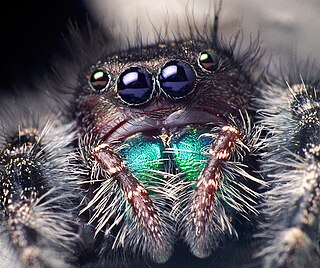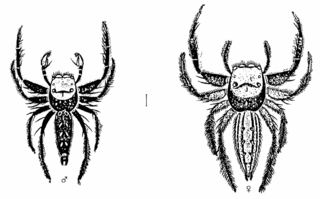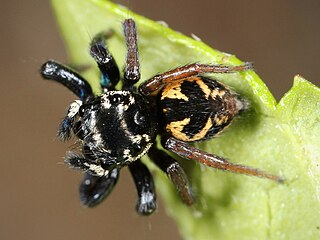
Theridiosoma is a genus of ray spiders that was first described by Octavius Pickard-Cambridge in 1879.

Phidippus is a genus in the family Salticidae. Some of the largest jumping spiders inhabit this genus, and many species are characterized by their brilliant, iridescent green chelicerae. Phidippus is distributed almost exclusively in North America, with the exception of two exported species. As of January 2021, there were about 80 described species in the genus. Species previously described in Phidippus which are found in India and Bangladesh do not belong in this genus.

Bavia is a genus of jumping spiders.

Breda is a genus of jumping spiders that was first described by George Peckham & Elizabeth Peckham in 1894.
Chirothecia is a genus of jumping spiders that was first described by Władysław Taczanowski in 1878.

Corythalia is a genus of jumping spiders that was first described by Carl Ludwig Koch in 1850.
Itata is a spider genus of the jumping spider family, Salticidae.
Ligonipes is a spider genus of the jumping spider family, Salticidae. Five of the six described species are found in the Australian region, the exception being Ligonipes similis, recorded as being from Sumatra. Their body form mimics ants.

Lyssomanes is a spider genus of the family Salticidae, ranging from South and Central America, up to the southern United States.

Marpissa is a genus of jumping spiders that was first described by Carl Ludwig Koch in 1846. The name is derived from Marpissa, an ancient Greek village.

Pachomius is a genus of jumping spiders that was first described by George and Elizabeth Peckham in 1896. Uspachia was merged into genus Romitia in 2007, and all nine species were merged into Pachomius in 2015. The name is derived from Pachomius, the founder of cenobitic monasticism.

Rhene is a spider genus of the family Salticidae.

Sarinda is a genus of ant mimicking jumping spiders that was first described by George and Elizabeth Peckham in 1892.

Synemosyna is a genus of ant mimicking jumping spiders that was first described by Nicholas Marcellus Hentz in 1846.

Viciria is a genus of jumping spiders that was first described by Tamerlan Thorell in 1877. The genus includes thirty-one accepted species.
Pseudamycus is a spider enus of the jumping spider family, Salticidae. The monotypic genus Taivala is thought to be closely related.

Maevia inclemens is a relatively common and colorful jumping spider of North America. In the males there are two forms, a very rare phenomenon in zoology. These use different courting displays, and differ in appearance: the "tufted" morph has a black body and pedipalps ("palps"), three black tufts across its "head", and pale legs; and the "gray" morph has black and white stripes all over its body and legs, orange palps, and no tufts. However, each form accounts for 50% of the adult males, and they are equally successful in mating. A female of Maevia inclemens is 6.5 to 8.0 millimetres long, while males are 4.75 to 6.50 millimetres long.

Paramaevia is a genus of jumping spiders in the family Salticidae. There are at least three described species in Paramaevia.
Matinta is a genus of South American jumping spiders. The largest number of species are found in Brazil.














